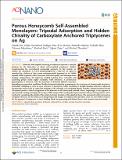Porous honeycomb self-assembled monolayers : tripodal adsorption and hidden chirality of carboxylate anchored triptycenes on Ag
Abstract
Molecules with tripodal anchoring to substrates represent a versatile platform for the fabrication of robust self-assembled monolayers (SAMs), complementing the conventional monopodal approach. In this context, we studied the adsorption of 1,8,13-tricarboxytriptycene (Trip-CA) on Ag(111), mimicked by a bilayer of silver atoms underpotentially deposited on Au. While tripodal SAMs frequently suffer from poor structural quality and inhomogeneous bonding configurations, the triptycene scaffold featuring three carboxylic acid anchoring groups yields highly crystalline SAM structures. A pronounced polymorphism is observed, with the formation of distinctly different structures depending on preparation conditions. Besides hexagonal molecular arrangements, the occurrence of a honeycomb structure is particularly intriguing as such an open structure is unusual for SAMs consisting of upright-standing molecules. Advanced spectroscopic tools reveal an equivalent bonding of all carboxylic acid anchoring groups. Notably, density functional theory calculations predict a chiral arrangement of the molecules in the honeycomb network, which, surprisingly, is not apparent in experimental scanning tunneling microscopy (STM) images. This seeming discrepancy between theory and experiment can be resolved by considering the details of the actual electronic structure of the adsorbate layer. The presented results represent an exemplary showcase for the intricacy of interpreting STM images of complex molecular films. They are also further evidence for the potential of triptycenes as basic building blocks for generating well-defined layers with unusual structural motifs.
Citation
Das , S , Nascimbeni , G , de la Morena , R O , Ishiwari , F , Shoji , Y , Fukushima , T , Buck , M , Zojer , E & Zharnikov , M 2021 , ' Porous honeycomb self-assembled monolayers : tripodal adsorption and hidden chirality of carboxylate anchored triptycenes on Ag ' , ACS Nano , vol. Articles ASAP . https://doi.org/10.1021/acsnano.1c03626
Publication
ACS Nano
Status
Peer reviewed
ISSN
1936-0851Type
Journal article
Description
S.D. and M.Z thank the Helmholtz Zentrum Berlin for the allocation of synchrotron radiation beamtime at BESSY II and financial support. The work was financially supported by the German Research Foundation (Deutsche Forschungsgemeinschaft; DFG) via grant ZH 63/39-1 (S.D. and M.Z.), EPSRC (doctoral training grant, R.O.d.l.M.), and CREST (Japan Science and Technology Agency; JST) via grant JPMJCR18I4 (T.F.) and also supported in part by “Dynamic Alliance for Open Innovation Bridging Human, Environment and Materials” from MEXT, Japan. The authors acknowledge financial support through the Austrian Science Fund (FWF): P28051-N36.Collections
Items in the St Andrews Research Repository are protected by copyright, with all rights reserved, unless otherwise indicated.

